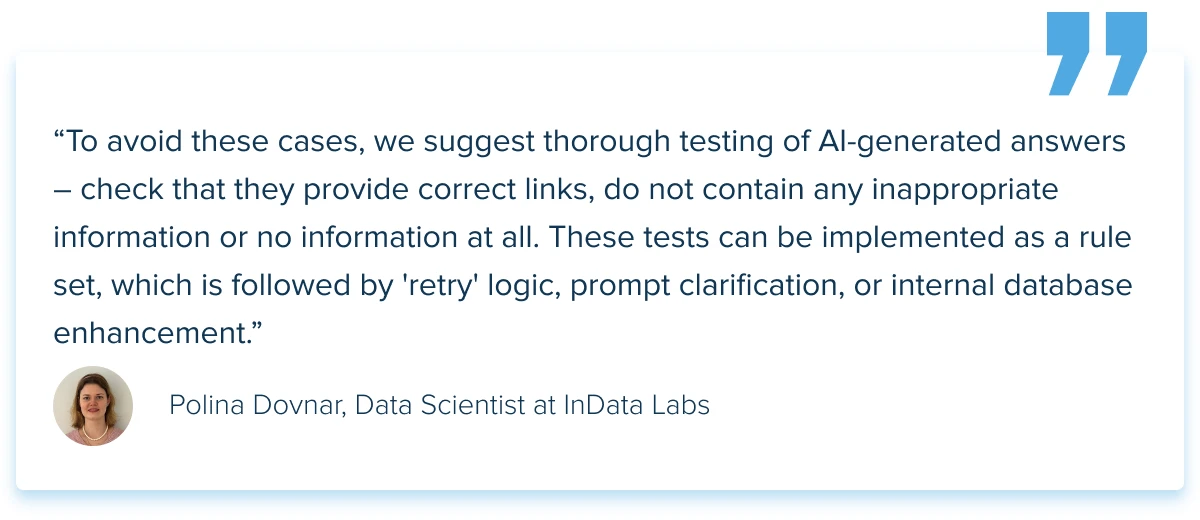Bias in generative AI – where does it come from? Today, artificial intelligence possesses transformative power in various aspects of society surprising us with its ever-improving ability to understand and mimic human cognition and intelligence. Its influence extends from information technology and health care to retail and art, penetrating our daily lives.
While this technology promises increased efficiency, productivity, and economic benefits, there are also concerns about the ethical use of AI generative systems. This article examines how generative AI challenges ethical and social boundaries, gauges the need for a regulatory framework, and provides solutions for bias reduction in AI.
Generative AI adoption today
Generative AI is recognized as the fastest-growing segment of the artificial intelligence market. Brainy Insights estimates that over the next 10 years, it will increase 20-fold, from $8.65 billion in 2022 to $188 billion by 2032. Another source, Bloomberg Intelligence, is more optimistic and predicts that by 2032, the generative AI market will grow to $1.3 trillion.
The global growth of chatbots and generative AI is also proven by the increasing demand for particular jobs. For instance, after the ChatGPT chatbot was launched, countless companies began to leverage ChatGPT for commercial use. This, in turn, resulted in an increase in the number of job postings containing “GPT” by 51% between 2021 and 2022. A stellar example of such jobs is a surge in demand for ChatGPT prompt engineering specialists nowadays, according to Time.

Source: Unsplash
Such a colossal growth speed is motivated by the technology’s immense potential and the growing demand for it across all sectors. Many organizations over the globe recognize Gen AI’s capabilities and, thereby, implement it across the board. Here are some companies that have adopted generative AI to enhance their services:
Pfizer is utilizing generative AI to increase its productivity in multiple directions, from scientific and medical content generation to manufacturing. Thanks to it, Pfizer has been able to accelerate drug discovery, reduce research timelines, and launch more medicines and vaccines faster.
Adobe is also integrating generative AI into various aspects of its software suite, particularly for image editing and design. Through its GenAI-based Adobe Sensei platform, Adobe introduced a number of features that enhanced content creation and manipulation and streamlined design processes.
Amazon is one more giant leveraging generative AI to improve its outcomes. Gen AI-powered algorithms help sellers create advanced product listings and engaging advertisements. For customers, it worked out palm payments, facilitated analyzing reviews by providing highlights, and, last but not least, built the widely-known Alexa voice assistant.
It was also recently reported that Google is working on a neural network that generates music based on text descriptions, which is quite unusual at the moment. It is noted that their AI models were trained on 280 thousand hours of audio recordings. The solution has several other innovative features but is not expected to be launched in the near future.

Types of AI bias
Artificial intelligence accuracy models intermittently discriminate against particular demographic groups. This bias can manifest in different forms. The most common among them include:
- Biases that result from stereotypes. In this case, systems adjust to the existing perceptions and stereotypes that are present in the training data.
- Racial bias. This type is a subset of stereotypical generative AI biases, yet one of the most alarming ones. Analyzing the present situation and views on different races, algorithms may provide racially biased content.
- Cultural bias. Another subset of stereotypical bias, this type, demonstrates unfair treatment and flawed outputs toward particular cultures and nationalities.
- Gender bias in generative AI is also present in generative models and has been around for ages, favoring men or women for certain jobs, responsibilities, and others.
Generative AI bias examples
Generative AI algorithms are increasingly integrated into the workflows of organizations. It accelerates the management of business processes by automating complex tasks, promoting innovation, and reducing manual work. Yet, the picture is not impeccable, while the machine learning models keep providing questionable results. To be more exact, people observe intermittent bias in artificial intelligence models.
For example, in 2022, Apple was facing charges that the oxygen sensor in their Apple Watch was racially biased. In one more well-known case, Twitter (to-date X) users found that Twitter’s artificial intelligence for automatic image cropping was gender and race-wise biased toward black race and men.
Sometimes, the insufficient accuracy of predictive models may lead to inaccurate decisions and negative consequences for innocent people. For instance, Robert McDaniel became the target of a criminal act in 2020 because of the insufficient accuracy of the AI model that identified him as a “person of interest”.

Source: Unsplash
We shouldn’t overlook bias in AI healthcare that can have severe consequences for patients. In 2019, Science figured out that a widespread medical algorithm had a racial bias, which led to black patients receiving worse medical care.
Buzzfeed’s “Barbies of the World” is among stellar examples of bias in artificial intelligence. In July 2023, they generated pictures of Barbie dolls from 193 countries using Midjourney. Internet users immediately pointed out racial and cultural inaccuracies in the outputs. For example, a German Barbie was wearing a Nazi uniform, while Barbie from South Sudan was pictured with a gun, which reflected deep AI algorithms bias.
This blog post caused controversial reactions due to cultural stereotypes and bias and highlighted the necessity for keeping AI under control by establishing quality standards and AI oversight bodies.
How to reduce bias in AI?
As the adoption of generative AI solutions grows, companies must become aware of how to combat biases in generative AI systems. Let’s have a quick peek at what forms the foundation of a fair AI model:
Diverse datasets
Generative AI bias often begins with the data that is used to train the models. That’s why the data for your dataset should be obtained from as wide a range of sources as possible. This ensures outputs are as accurate as possible.
Comprehensive testing
Testing is the key to ensuring that the model isn’t biased. To avert inherent unfairness, it’s vital to conduct a rigorous testing process for all types of generative AI biases before these models reach the launching stage.
Testing is also a great solution against AI glitching when it answers based on data of general knowledge instead of the data limited by your business dataset.

Focus on transparency
To ensure artificial intelligence fairness, companies should prioritize transparency and clearly explain the decision-making process behind their AI algorithms. It will help users feel more comfortable with the algorithm’s fairness and create trust in your organization.
Constant monitoring
Monitoring and updating are necessary to ensure that your model provides fair and relevant results. Firstly, it implies monitoring that your data and the sources it’s taken from don’t contain bias. Secondly, teach your algorithm to recognize bias in this data and bring it to a human’s attention. A machine controlling itself in preventing biased outputs could work excellently here.

Existing regulations that prevent AI bias
The rapid increase in the popularity of generative language models and AI chatbot development has pointed out the need to regulate artificial intelligence. Today, generative AI lacks a comprehensive regulatory framework, which raises concerns about its detrimental impacts on society.
Today, different parties of interest advocate for strong regulatory frameworks. For example, the European Union has proposed the first-ever world-level AI regulatory framework to inspire confidence, which is expected to be adopted in 2024. This document will contain rules related to AI applications that can adapt to technological changes. It also proposes to establish obligations for users and suppliers and offer pre-sale conformity assessment and after-sale enforcement within a certain management structure.
All in all, the introduction of a regulatory framework would be a significant step in addressing the fairness risks associated with generative AI. Having a profound impact on society, this technology needs oversight, careful regulation, and ongoing dialogue among stakeholders.
By the end of 2019, at least a hundred different acts, guidelines, and principles on AI ethics had been adopted worldwide. Most of them contain several key principles: security, confidentiality, non-discrimination, auditability, and others. One of the earliest well-known regulatory documents is the Asilomar AI Principles, which has a subsection with 13 ethical AI principles. Among them are responsibility, human values, non-subversion, value alignments, and others.
Another earliest regulatory document is the Montréal Declaration on Responsible AI, which is based on the following values: well-being, autonomy, intimacy and privacy, solidarity, democracy, equity, inclusion, caution, responsibility, and environmental sustainability.
In March 2023, the Head of SpaceX, Tesla, and X, Elon Musk, co-founder of Apple Steve Wozniak, and over a thousand experts and industry leaders in generative AI development signed a letter calling for the suspension of the development of advanced AI until security protocols are introduced and verified by experts.
Future of Life Institute agreed with the proposition stating that “advanced artificial intelligence systems should be built only when we are sure that their impact will be positive and the risks managed”.
In July 2023, UN Secretary-General Antonio Guterres supported the idea of creating a UN-based body to formulate global standards for regulating AI. He outlined five goals and tasks of this body:
- To help countries maximize the benefits of AI;
- To address existing and future threats and risks;
- To create and implement international monitoring and control algorithms;
- To collect AI expertise and make it available to the global community;
- To teach AI so that it helps accelerate sustainability.
Developing comprehensive regulatory standards will definitely take a while, so some countries worked out temporary documents, as did China in August 2023. It came up with temporary regulations on generative AI, which aims to improve AI accuracy models and their reliability, protect users’ personal data, and respect intellectual property and privacy rights. The rules establish the need to prevent discrimination on any ground, while developers are required to provide a clear mechanism for complaints and feedback.
On the one hand, AI can significantly accelerate global development. It can be used for a variety of purposes, from controlling the climate crisis or human rights to enhancing medical research. On the other hand, AI can increase prejudice and discrimination among the population of different countries. That’s why, it is critical to work out and continuously optimize guidelines to reduce GenAI bias.
The benefits of generative AI adoption in business
The adoption of GenAI solutions into business opens a myriad of growth opportunities. If you build a customized product that addresses your critical challenges, you receive the following:
1. Better customer experience
Leading-edge software is capable of taking your customer services to the next level. For instance, with a GenAI-powered chatbot, your clients receive immediate answers, get connected to the necessary specialists faster, and can make appointments, purchases, or any inquiries in a moment. As a result, you streamline interactions with clients, and increase their loyalty and conversion rates.

Source: Unsplash
2. Overall workflow automation
There are a number of mundane and time-consuming tasks that can be delegated to the smart generative AI system. From general inquiries about information from the business’s database to more complex content generation, design iteration, data synthesis, or management tasks – the AI system can speed up all of these processes. This allows employees to focus on more strategic and high-value tasks while reducing associated costs and optimizing productivity.
3. Cost savings
With many processes automated and optimized, productivity increases dramatically. This, in turn, increases profits. Moreover, a lot of human effort is needed to perform time-consuming tedious processes. But with implemented generative AI algorithms, the need for human resources is reduced. As a result, you cut down expenses and multiply income.
4. Enhanced innovation
Gen AI also drives innovation by assisting in the generation of new ideas, designs, and solutions that may not have been considered through traditional methods. AI-generated insights and content can help businesses discover unconventional solutions to complex problems, leading to breakthroughs in product development, process optimization, and competitive advantages in the market.
5. Competitive advantage
The adoption of these systems provides businesses with a competitive edge and helps them innovate faster, personalize customer experiences, optimize internal operations, and make data-driven decisions. Businesses can utilize AI-generated insights and content to stand out in the market, adapt to changing customer needs, and stay ahead of industry trends.
Gen AI implementation: Challenges and solutions
Implementing generative AI solutions in business, like any other its brunches, might seem burdensome due to some challenges that may arise. Any unprepared business can face them and the point is to overcome these challenges wisely and even dodge them at the outset. So, check out the list below to see what kinds of problems you may come across and how to work them out.
Cultural, racial, and other types of bias
Concerns about bias in algorithms’ outputs reflect and perpetuate biases present in the training data. As a result, AI systems may reinforce stereotypes or discriminatory patterns existing in society.
Solution: To prevent it, it is critical to establish ethical frameworks for the use of generative AI. You should foster diversity in the training data and development teams. What’s more, building bias detection mechanisms, regular audits, and gathering feedback will be beneficial too.
Data quality & quantity
Firstly, if data is insufficient, it results in flawed or limited outputs, which eventually deteriorates the accuracy of generated content. Secondly, it is a mistake to collect single-type data.
Solution: It is vital to source diverse datasets and reliable channels, use data augmentation techniques to enhance dataset diversity and size, constantly enrich them, and go for rigorous data preprocessing and cleaning methods.

Source: Unsplash
Regulatory compliance
Adhering to data protection regulations and industry-specific compliance standards can be complicated when using generative AI models, especially in regulated sectors such as healthcare and finance.
Solution: As a solution, you should strictly adhere to data protection regulations such as GDPR and HIPAA. Additionally, it’s useful to develop encryption standards, conduct regular audits and updates, as well as involved in it with legal and compliance experts to stay aware of changes in regulations.
Domain expertise
Many businesses lack in-house expertise in building reliable Gen AI solutions as it requires deep knowledge and sufficient experience in the domain.
Solution: A brilliant solution here is to collaborate with domain experts and request them to build a solution to bridge knowledge gaps. They will not only help you overcome challenges but also create a reliable well-thought-out product for your business.
Implementation expenses
The adoption of generative AI models requires close attention to building their infrastructure, hiring talent, and ensuring continuous refinement. But it can be even more costly if some points are overlooked and done wrong.
Solution: To avoid extra expenses, it’s vital to perform a thorough cost-benefit analysis to calculate the potential return on investment. And no doubt, considering the tips above and averting challenges will save a palpable part of your budget too.
How to choose the right vendor and ensure AI model accuracy?
As we can see from above, generative artificial intelligence models are picking up steam with more and more companies seeking AI business integration in their workflows. However, delivering a reliable solution sounds not easy while the number of generative AI and chatbot development companies seems endless.
So, how to select the right partner to implement the desired solution and avoid pitfalls? Here are several tips for you not to get lost:
1. Expertise is critical
While the desire to help everyone is generous, it can’t solve existing problems to the fullest. That’s why when selecting a partner for your AI business solutions, seek one who has knowledge, proven practices, and experience in your area of interest. It regards both an IT domain and industry expertise. Such a partner will bring a wealth of know-how and attention to minor details since they have already gone through it and can guide you along the way.
2. Make sure you know what you need
Any solution will not work properly for your business if you haven’t targeted it to solve the alarming problems. That’s why it’s vital to be sure you are building the solution that will bridge the necessary gaps and enhance other processes too.

3. Check out the portfolio
While expertise in your industry and domain are significant, we shouldn’t overlook the portfolio section either. This will help you find out what solutions the vendor in question has built and how similar or different they are from your project. What’s more, even a peek at the featured works will show you the vendor’s focus and strongest points.
4. Do not be guided by prices only
Price is a good criterion to consider as it is directly connected with your budget. Yet, the price will never be the indicator of the quality of provided services. As there are relatively cheap and high-quality solutions, there also exist costly services of questionable quality. The takeaway here is that cheap services aren’t always bad, and expensive services do not always guarantee success either. The wise solution here is to find the best-suited solution for your business, and it will be the most cost-effective decision.
5. Go for bespoke solutions
Off-the-shelf solutions are time-proven and might be at the hearing but they never fill all the gaps of the businesses that utilize them. We must recognize that these are solutions built to cover the most common needs and aimed to suit a bigger number of businesses. But no solution will bring you such a range of benefits as the one built for your unique needs and requirements. So, you should look for a partner that can provide you with customized services and help you work out the best-working AI integration solution for your business.
These criteria will help you weed out unreliable candidates and make the best choice. Just stay focused on what your business will benefit more from, and you will find the partner for your future projects.
Wrapping it all up
Generative artificial intelligence is markedly gaining velocity in today’s society. From chatbots to voice assistants, it perpetuates the modern world and has immense potential for future uses. However, the picture is not all good, and generative AI adoption still poses several challenges for businesses with biased outputs as one of the most alarming concerns.
As Sigmund Freud stated, acknowledging the problem is half the success in solving it. The same is in artificial intelligence bias – if we teach models to recognize bias, address and eliminate it, if we give proper learning data, only then can we achieve success in grappling with bias in AI. Steps toward it are already being done, and today fair AI is just a matter of meticulous work and careful approach to generative AI implementation.
FAQ
-
Bias in generative AI models refers to the presence of unfair, or stereotypical generated content. This bias usually results from the training data and reinforces prejudices, or societal inequalities present in the data.
-
AI algorithms bias implies systematic and unfair prejudices that AI systems may demonstrate. This can lead to discriminatory outcomes in decision-making processes or biased predictions.
-
Generative AI sometimes falls under criticism. The reasons are its possible biased outputs, ethical concerns related to the creation of fake or misleading information, and the need for greater transparency in the development of AI-generated content.
-
It’s better to utilize different techniques in identifying bias, the most promising among which include:
- Using fairness metrics to assess the model’s performance across different demographic groups
- Implementing bias detection tools for constant monitoring
- Performing audits of the training data
- Evaluating ethical reviews left by experts and users.
-
The problem of bias is highly alarming as it can lead to discriminatory outcomes, reinforce inequalities in society, and weaken trust in AI systems. It can also result in unfair treatment or inaccurate predictions, impacting business decision-making and communities on the whole.
-
The techniques that help reduce bias and ensure inclusive AI systems include:
- Gathering data from multiple diverse sources
- Training models with fairness in mind
- Detecting bias as early as possible
- Make use of review processes.
-
While the complete elimination of bias in AI algorithms may be challenging, we definitely can reduce it significantly through continuous attention and improvement in data collection, model development, and ethical guidelines.
-
The most vivid types of biases are cultural, stereotypical, racial, and gender biases based on the primary reason for unfair outputs.



